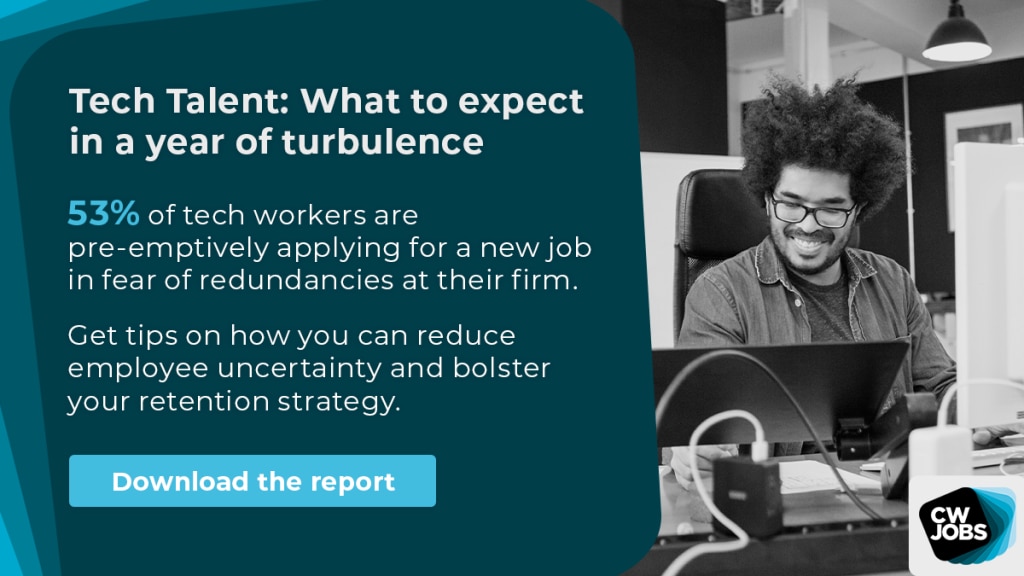The trends that will shape tech recruitment in 2023
Politically and economically, 2022 was a turbulent year. And during times of uncertainty, the business landscape comes to rely more heavily on technology to continue operations.

Our analysis of the impact of the cost-of-living crisis on the tech industry found that IT spending is set to increase, the tech skills shortage will continue, and the tech industry will increase salaries to attract more talent.
Diving deeper into what 2023 holds for tech recruitment, our most recent research takes a closer look at the trends employers should look out for this year. We surveyed 2,000 tech workers to learn more about how they’re approaching their job search in 2023.
Employers and recruiters can use these insights to secure top tech talent quickly and to develop more effective attraction and retention strategies.
Employer branding will differentiate companies in the marketplace
Our survey reveals that 53% of tech workers are pre-emptively applying for a new job in case of redundancies at their firm. In an industry that already has a skills shortage, (the number of tech job vacancies in the UK rose to a record high of 502,151 between October and December 2022) this provides recruiters with an opportunity to gain the attention of top talent that are looking for job security.
One way companies can stand out in a candidate-driven market is to invest in their employer brand. Using a data-driven approach to branding can help companies define their identity, showcase their strengths and create a compelling employer value proposition.
Making use of an employer brand consultancy like Universum can help employers refine their offerings to appeal to the type of talent they want to attract.
Job adverts will become more detailed
Our research finds that tech workers will be more selective in the roles they apply for in 2023. One in five (20%) said they wouldn’t bother applying for a job if they didn’t have more than three quarters of the requirements in the job advert.
With candidates taking a more discerning approach to applications, employers and recruiters should strive to include more detailed information in job adverts. The top details that tech candidates want to know are salary (46%), location (34%), required skills (31%), employee benefits (30%) and working hours/time models (29%).
Having these details up front enables candidates to make an informed decision about whether a role is right for them. It can also help employers secure more applications as candidates won’t be put off by missing information.
Location in particular, will be an important element to include in adverts this year, as over half of tech workers (55%) are looking for a combination of home and office working. Employers therefore need to stay up-to-date with the latest working practices and ensure they’re offering the type of flexibility that candidates expect.
A stronger focus on upskilling and DE&I
With 1 in 5 candidates saying they wouldn’t apply for a role if they didn’t have at least 75% of the requirements, employers could be missing out on quality candidates by not highlighting upskilling and training opportunities.
Many employers are now including a disclaimer on job adverts to emphasise the point that training and development is provided in a role. This helps ensure that candidates who don’t meet all the criteria still feel confident to apply. This inclusive approach ensures employers don’t exclude individuals who have an aptitude for learning the skills they’ll need.
Recruiters should also include their company’s diversity, equity and inclusion (DE&I) policy in job adverts. Tools like Equality Boost can increase applications from underrepresented groups. By harnessing demographic and social mobility data, recruiters can pinpoint when, where and how to reach top talent.
Time to hire will improve
In a competitive job market, employers need to secure candidates quickly so they don’t lose out to the competition. Our research reveals that 26% of tech workers have dropped out of a job application because the recruitment process was too slow.
Today, candidates are more likely to expect instant decisions and feedback on applications. Using the latest tech recruitment software like CWJobs’ Instant Candidate Recommender can help employers streamline the recruitment process and ensure candidates are updated at every stage of their application.
Our survey also shows that, on average, applicants expect to participate in two interviews, and the biggest proportion of candidates expect the entire recruitment process to take two to three weeks. For many companies, this will mean reducing their time to hire and onboarding candidates quicker.
Tools like CWJobs’ video recruiting software enables HR to set up meetings in minutes, work across any device, and conduct live video calls. The software can also be used to help companies onboard new staff remotely.
For more insights into the tech recruitment trends of 2023, download our full report, here.